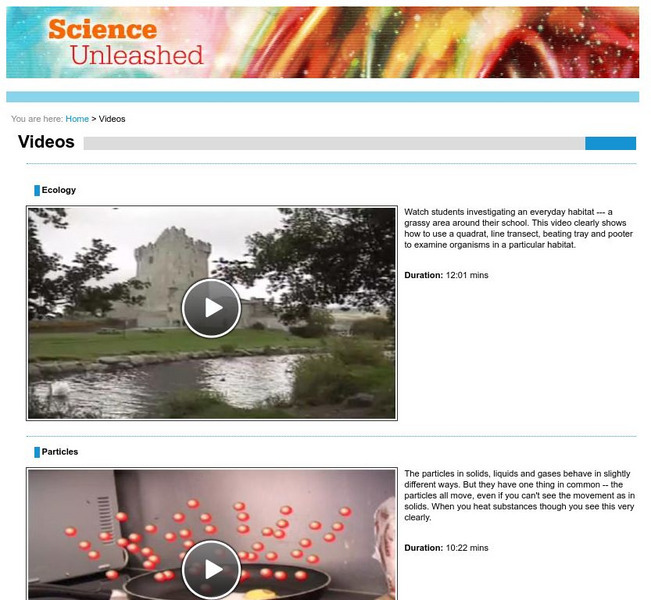Hi, what do you want to do?
Be Smart
Attack of the Zombie Parasites!
There is a law in Haiti that makes it a crime to turn someone into a zombie. But is such a thing even possible? Scholars see examples of zombie-like organisms found here on Earth with a video that explores numerous examples, from...
Bozeman Science
Protists
Where do we put the organisms that don't fit in the other eukarya groups? We call them protists. A video explains why there is so much variety within the kingdom and the few things they do have in common with each other.
Bozeman Science
Molecules of Life
Introduce the macromolecules that make up living organisms. An instructive explains functional groups, dehydration and hydrolysis, and the four types of macromolecules. Video is the seventh in a series of 10.
TED-Ed
What Is the Biggest Single-Celled Organism?
Meet Caulerpa taxifolia, believed to be the largest single-celled organism in the world. How does it work and where is it found? Learn all about this invasive algae and why it is so successful.
TED-Ed
How a Single-Celled Organism Almost Wiped out Life on Earth
Meet cyanobacteria, the single-celled organism that changed the world by causing the first mass extinction of life forms, gave rise to oxygen breathing life forms, and was responsible for the first Ice Age.
Ricochet Science
Organization of Life
What do matryoshka dolls have to do with the organization of life? Young scientists learn about the levels of organization of life in the last installment of a five-part video series. The video covers the cellular, organismal, and...
Amoeba Sisters
Biological Levels: The World Tour
It might look like he's doing nothing, but at the cellular level, he's quite busy. A video provides an overview of the many different biological levels. Using two different graphic organizers and many cartoon drawings...
Ricochet Science
Osmosis and Tonicity
Does your class get confused when discussing osmosis and tonicity? Explore the relationship between osmosis and tonicity to further differentiate between the two processes. The lesson concludes with a class-led discussion about...
Ricochet Science
Channel Proteins
Provide your class with a simple explanation of channel protein movement. Pupils view a short video segment and explore how channel proteins move ions across a plasma membrane. They conclude the lesson with a short discussion of...
Ricochet Science
Features of Eukaryotic Cells
What is the difference between plant and animal cells? Explore their details as your class views the short video segment. They compare the features of plant and animal cells including the nucleus, nucleolus, endoplasmic...
Crash Course Kids
The Basics of Freshwater
Most of the water on Earth is found in our oceans; however, humans cannot survive on salt water. Instead, we need freshwater. So, what is freshwater and where does it come from? This is the focus of a video that discusses the differences...
Crash Course Kids
The Dirt on Decomposers
What happens to all the waste created in nature? This is the focus of a video that explains how decomposers break down waste to be used as nutrients and turned into energy for other living organisms.
Crash Course Kids
Fabulous Food Chains
What is a food chain? Energy flows between living things in a food chain. This is the focus of a video that explains how food chains work.
Crash Course Kids
Feed Me: Classifying Organisms
How do different types of living things get the energy they need? This is the focus of a video that describes how carnivores, herbivores, and omnivores get the energy they need to live.
TED-Ed
At What Moment Are You Dead?
When is a person no longer living? This question has been puzzled over for millennia, but is there a clear answer? Watch as this video examines the biological line separating life and death.
Curated OER
Wetlands - Pond Study
Observe a pond's tiniest life forms. Zoom in on Daphnia, also called water fleas, a type of crustacean that often dwells on the pond floor.
BioEd Online
Bio Ed Online: Introduction to Organisms
Organisms are divided into each of five kingdoms based on defining characteristics. Learn about the classification kingdoms and the placement of organisms within them. [1:14:02]
Khan Academy
Khan Academy: Biodiversity and Natural Selection
Explore the patterns and processes of evolution. Learn how evolution and natural selection are reflected in the similarities and differences of organisms. [9:03]
Bozeman Science
Bozeman Science: Hierarchy of Life
Paul Andersen explains how biology is ordered in the hierarchy of life. He first of all describes how emergent properties appear as you move to more inclusive systems. The then describes life at the following levels; atom, molecule,...
National Centre for Technology in Education
Science Unleashed: Videos
Fifteen short videos that explore some Junior Certificate science concepts.
Sophia Learning
Sophia: Living Organisms and Their Environment: Lesson 4
This lesson will discuss the interactions of and interdependence among living things. It is 4 of 4 in the series titled "Living Organisms and Their Environment."
Bozeman Science
Bozeman Science: Organ Systems
Paul Andersen explains how organs work together to form organ systems and how organ systems work together to form organisms. The kidney and bladder work together to filter blood in the excretory system. The circulatory and respiratory...


























